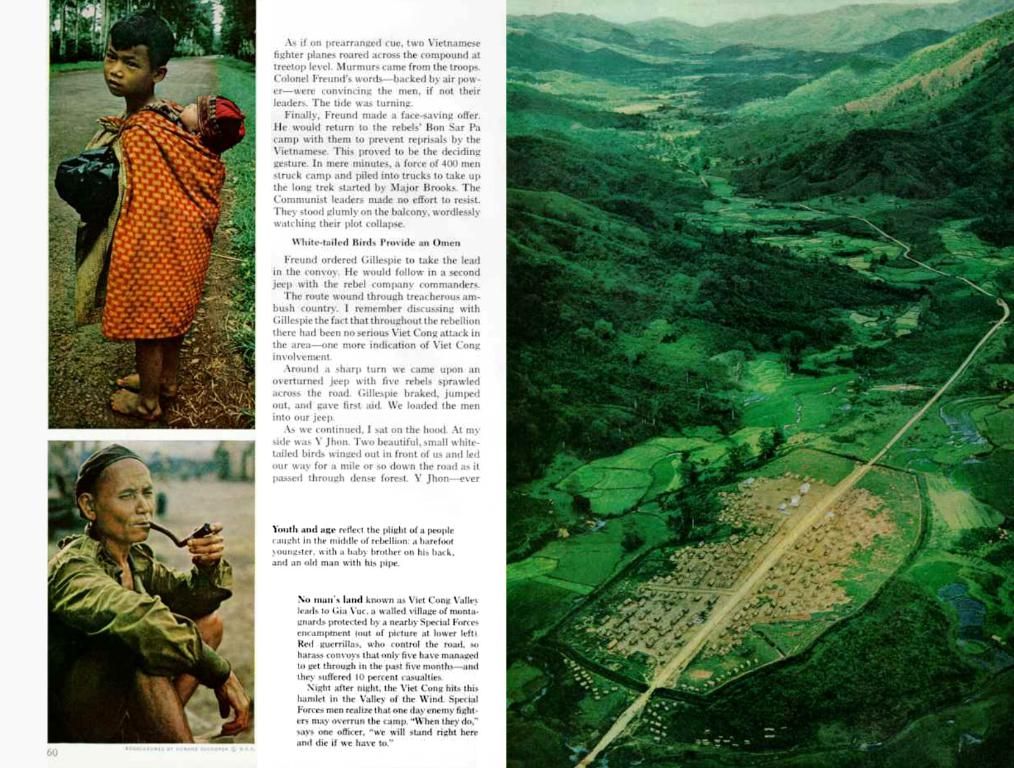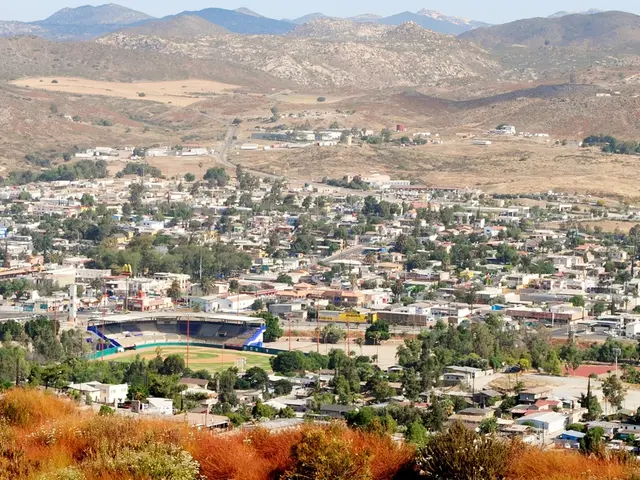Beneath the Rockies' Surface: Discoveries of Dinosaur Footprints and Marine Fossils Unveil Alberta's Prehistoric Seas
Venture to the sun-soaked prairies of Alberta and gaze upon the colossal Rocky Mountains, their majesty whispering tales of a time when these lands were submerged in a vast, ancient ocean teeming with sea monsters and colossal reptiles. beneath your feet lies a chronicle older than the mountains, narrated by fossilized footprints and the fragments of creatures that once reigned both land and sea. If you've ever pondered the secrets hidden beneath those rugged peaks, strap on your explorer's hat and get ready to delve into a realm more fantastical than any myth.
From Sea to Summit: The Transformation of Alberta
Before the Rockies soared to the heavens, Alberta bore an entirely different landscape. Over 100 million years ago, much of what is now prairie and mountain was submerged under a warm, shallow sea known as the Western Interior Seaway. This expansive body of water extended from the Arctic Ocean down to the Gulf of Mexico, cleaving North America into two. Envision standing where Calgary resides today, with nothing but endless, saline waves beneath you. Over millions of years, the relentless force of tectonic activity pushed up the land and drained the seaway, culminating in the formation of the mountains. This slow, continuous metamorphosis mimics the very breath of the planet itself, as it sedimented stories of change into the earth.
Discovering Alberta's Dinosaur Trackways
Roaming through sections of Alberta, you may chance upon peculiar, three-toed indentations pressed into stone. These are dinosaur tracks - some so perfectly preserved they seem to visualize their colossal, ancient inhabitants racing by. Spots like the Grande Cache trackways boast thousands of these sites, etched with the fossilized footprints of herds of duck-billed dinosaurs and fearsome predators. Each impression relays a narrative: the speed at which the dinosaur moved, its solitary or communal nature, and even the weather conditions of that distant day. These traces offer a captivating, intimate glimpse into the lifestyles of dinosaurs - much like snippets from a prehistoric photograph album.
The Western Interior Seaway: Alberta's Ancient Ocean
The Western Interior Seaway was no ordinary marine expanse. Imagine a vast, tropical lagoon teeming with life - sometimes barely waist-deep, and at other times plummeting into dark, cold abysses. This body of water was the habitat of some of the most peculiar and fearsome marine reptiles ever to exist. Mosasaurs, akin to T-Rexes of the sea, patrolled its waters, while plesiosaurs graced the lagoon with their long necks and paddle-like limbs. The ever-evolving shoreline created a patchwork of diverse habitats, from sunlit reefs to muddy tidal flats - each preserving its distinctive collection of fossils. As you stroll Alberta's terrain, her rocks still echo with the whispers of these ancient tides.
Marine Fossils: Windows to the Deep
Beneath Alberta's surface, the rocks hold a treasure trove of marine fossils - time capsules from the deep. Ammonites, spiral-shelled cephalopods, are abundant, and their pearly shells have been admired as far back as the Egyptians, sometimes reaching car tire dimensions. Belemnites, resembling bullet-shaped fossils, and fossilized fish with armored plates and tooth-filled jaws can also be found. These fossils provide insight into the lives of marine creatures in Alberta's ancient seas, revealing tales of their hunting strategies, miniature ecosystems, evolution, and eventual demise as the seas receded.
Dinosaur Tracks: Accounts of Behavior and Ecosystems
From the perspective of dinosaur tracks, it's not just about where dinosaurs walked - they expose the behavior and ecosystems of these prehistoric titans. By studying the spaces between footprints and their depths, paleontologists can estimate the size and speed of the dinosaurs. Some trackways illustrate herds traveling together, suggesting complex social dynamics. In some sites, predators and prey footprints cross paths, hinting at ancient pursuits frozen in time. These traces expose not just the aesthetics of dinosaurs, but their tactics for survival in a world constantly reshaped by change.
Ancient Predators: Mosasaurs and Pliosaurs
If dinosaurs instill fear, then prepare to meet the marine reptile sovereigns that controlled the Western Interior Seaway. Mosasaurs, the "T-Rex of the sea," grew longer than a school bus and were fitted with jaws filled with sharp teeth. Their powerful tails sent them darting through the water like a speeding bullet. Pliosaurs, massive with short necks, utilized sheer brute strength, crushing almost anything in their powerful jaws. Discoveries of these creatures' fossil remains reveal the diversity and ferocity of prehistoric marine life, recounting tales of epic underwater battles and the dominance of food chains anything but peaceful.
Gentle Giants: The Plesiosaurs of Alberta
It's not all doom and gloom - not all marine reptiles were terrifying. Plesiosaurs, with their elongated necks and petite heads, appeared almost elegant as they glided through the seaway. These gentle giants likely subsisted on fish and minor marine species, using their flexible necks to snatch prey from the water. Fossil remains of these creatures discovered in Alberta have aided scientists in understanding their swimming patterns, hunting habits, and reproductive strategies - adding a touch of elegance to Alberta's fossil record.
The Ammonite Enigma: Alberta's Ancient Treasures
Ammonites are among the most captivating and mysterious fossils discovered in Alberta. Their spiral shells, often shimmering with iridescent hues, have captured the hearts of collectors for centuries. More than just pretty decorations, however, ammonites were efficient predators, utilising their jet-propelled bodies to chase down prey. Their fossilized shells can reveal details about ancient ocean temperatures and chemical compositions, serving as historical weather reports. Some indigenous groups also consider ammonites sacred stones, recognizing their power to connect the past to the present.
Fossil Fish: Survivors of a Forgotten World
Ancient seas brimming with fish unlike anything alive today inhabited Alberta. Some were armored like tanks, their thick plates offering protection, while others possessed odd jaws that could crush shells or snap up smaller fish in a flash. Fossil beds near Drumheller have yielded schools of these prehistoric swimmers, entombed by sudden mudslides or changes in sea levels. Studying these fossils unravels the evolutionary strategies fish employed to survive amid a world brimming with hazards - from massive marine reptiles lurking above to predators lurking below.
Trace Fossils: More than Bones and Shells
Not all fossils are bones or shells. Trace fossils, such as burrows, feeding marks, and feces, reveal details that painting a different kind of picture of the past. In Alberta, these traces abound, offering glimpses into the daily lives of ancient creatures. Worm burrows crisscross the land, showcasing the hiding spots of animals attempting to escape predators. Ripple marks and mud cracks preserve signs of tidal changes and their influence on the seafloor. Even fossilized dung, known as coprolites, can provide information on what prehistoric creatures consumed. Reading between these lines is akin to perusing an old diary, revealing the details that today's scientists are yet to decipher.
The Drumheller Valley: Alberta's Fossil Hub
If there's a beating heart to Alberta's fossil-packed terrain, it's the Drumheller Valley. Rich with dinosaur remains, marine reptiles, and prehistoric flora, this region has served as a hub for both scientific discovery and popular fascination for years. The Royal Tyrrell Museum, established on the valley's perimeter, boasts one of the most extensive collections of fossils worldwide. Wandering this valley, visitors can stumble upon bones and shells protruding from the ground - each offering a glimpse into the distant past frozen in time. The valley's raw beauty and abundant fossils have made it a globally recognized hotspot of prehistoric history.
Dinosaur Provincial Park: A UNESCO World Heritage Site
Dinosaur Provincial Park is more than a scenic destination - it's a UNESCO World Heritage Site distinguished for its staggering diversity of fossils. Here, scientists have unearthed well over 40 species of dinosaurs, in addition to marine reptiles, turtles, and fossilized trees. The park's landscape is a labyrinth of ravines and hoodoos, each stratum preserving a distinct period in Alberta's ancient history. Guided tours and educational programs immerse visitors in the fossil-filled terrain, transforming the park into a living classroom for anyone captivated by Earth's prehistoric past.
What Fossils Reveal About Ancient Climates
Fossils aren't merely aesthetic trophies - they serve as powerful tools for understanding Earth's long-past climates. By examining the types of plants and animals discovered in Alberta's rocks, scientists can reconstruct what the environment was like millions of years ago. Fossils can reveal clues about the air and water temperatures, the prevalence of diverse ecosystems, and even the cyclical patterns of the planet's geological history. These revelations inspire us to look more closely at the world around us, to cherish its mysteries, and to marvel at the intricate patterns of change that have shaped our planet.
Mass Extinctions: Alberta's Fossil Graveyards
Not all stories told by the fossil record are happy ones. Alberta's rocks bear witness to several mass extinction events - epochs when life on Earth seemed on the brink of vanishing. During these periods, entire species - such as dinosaurs and many marine creatures - disappeared suddenly and mysteriously. In some layers, you can see this devastation firsthand - a layer of clay enriched with iridium, marking the fallout from massive asteroid impacts. These fossil cemeteries remind us of the fragility of life, and the devastating impact a single catastrophe can have on Earth's inhabitants.
Ice Age Overprints: Fossils in a Shifting Landscape
Following the dinosaurs' demise and the draining of the seas, Alberta's landscape continued to evolve significantly. During the Ice Age, massive glaciers carved their paths across the area, altering the terrain for hundreds of kilometers. On occasion, these glaciers uncovered new fossils or buried ancient ones under thick layers of gravel. The constant reinvention of the landscape reveals that new discoveries are being made all the time - sometimes in the most unlikely places, such as farmlands or construction sites. The interplay between ancient seas and recent ice has produced a fossil record that is complex and rich with secrets waiting to be unveiled.
Modern Science Meets Ancient Mysteries
In modern times, the examination of Alberta's fossils has been revolutionized by contemporary technology. CT scans and 3D modeling allow scientists to peer inside bones without damaging them, disclosing details about muscle attachments, blood vessels, and even diseases. Chemical analysis can divulge what ancient creatures consumed or how they grew. These technological advancements facilitate the resolution of longstanding mysteries - like why some dinosaurs walked on two legs, or how marine reptiles reproduced. An ever-expanding pool of knowledge about Alberta's prehistoric past is unveiled, highlighting the magnitude of transformation our world has endured over time.
Indigenous Knowledge and the Land's Stories
Before the arrival of scientists, indigenous populations recognized the significance of the fossils found in Alberta. Stories about "thunder lizards" and sacred stones have been passed down through generations, weaving a bond between the ancient past and the present-day culture. The Blackfoot people, for example, use ammonite fossils in their ceremonies, recognizing their spiritual power. Collaborative efforts between scientists and indigenous communities unite the wisdom of traditional knowledge with the logic of western science, preserving Alberta's paleontological legacy for future generations.
The Ongoing Hunt: Citizen Scientists and New Discoveries
You don't have to be a professional scientist to make an essential fossil discovery in Alberta. Every year, hikers, farmers, and even schoolchildren stumble upon ancient bones and shells. The province encourages members of the public to report their findings, fostering a collective commitment to the exploration of Alberta's prehistoric past. These discoveries demonstrate that the ancient seas of Alberta still conceal secrets waiting to be revealed - sometimes hidden in plain sight, just under the surface. The exhilaration of unearthing a fragment of the forgotten past is an opportunity available to anyone willing to embark on the journey.
What Alberta's Fossils Teach Us About Change
When standing in Alberta's fossil-rich badlands, it's challenging to ignore the feeling of awe inspired by the sheer scale of transformation that has shaped this land. Each fossil represents a glimpse into a world lost to eternity, a time when Continents were rearranged, oceans were born, and life roamed free. The stones whisper tales of vanished seas, lost worlds, and creatures too strange to fathom. Each fossil serves as a reminder of the impermanence of existence, the power of change, and the mesmerizing beauty of our planet's past.
- The fossilized footprints beneath your feet in Alberta's terrain narrate a story older than the mountains, revealing details about creatures that once roamed both land and sea.
- New scientific advancements, like CT scans and 3D modeling, aid in the resolution of longstanding mysteries found in Alberta's fossil record, such as dinosaur locomotion and marine reptile reproduction.
- Citizen scientists and hikers contribute to ongoing discoveries in Alberta's fossil-rich terrain, as everyday individuals stumble upon ancient bones and shells while exploring the province.
- Indigenous communities have recognized the spiritual connection between themselves and Alberta's fossils for generations, incorporating ammonite fossils into their ceremonies, and collaborating with scientists to preserve and understand the province's paleontological legacy.
- Traveling through sections of Alberta, you may encounter fossilized dinosaur tracks imprinted into stone - these traces offer not just an aesthetic image, but a captivating snapshot into the lifestyles, behaviors, and ecosystems of dinosaurs, serving as a window into a prehistoric photograph album.








